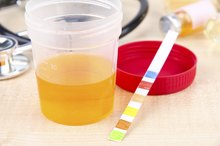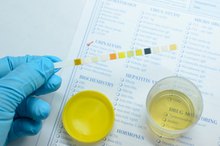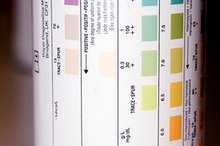Abnormal Urine Analysis
Urine analysis is commonly called urinalysis. You provide a urine specimen to your doctor, who in turn sends it to a lab to be analyzed. The most routine type of urinalysis involves a dipstick test in which an indicator stick is dipped into the urine. Multiple tests are performed using a single indicator stick. The results of these tests provide important clues for a number of different conditions and provide guideposts for further testing and treatment.
Protein
Urinalysis typically involves testing the urine for protein. According to the National Kidney Foundation, the presence of protein in urine is abnormal and is a red flag for kidney disease 12.
If urinalysis is performed using the dipstick test, results are reported back as "Neg.," "Trace," "+1," "+2" and so forth, with the amount of urine protein increasing in step with the higher reported value. "Neg" and "Trace" are considered normal.
If levels of urine protein are abnormally high, doctors usually order that the test be repeated. If subsequent tests are also abnormal, a referral to a nephrologist usually occurs.
- Urinalysis typically involves testing the urine for protein.
- If urinalysis is performed using the dipstick test, results are reported back as "Neg.," "
Red Blood Cells
What Causes Epithelial Cells in a Urinalysis?
Learn More
Abnormal levels of red blood cells in the urine also raise the possibility of kidney disease. While some patients are aware of blood in their urine, many patients are unaware until they get an abnormal urinalysis result.
According to the National Kidney Foundation, abnormally high levels of red blood cells are associated with more than 100 different diseases 12. These include "abnormal structures in the urinary tract, inherited diseases, mineral imbalances in the urine and glomerulonephritis."
- Abnormal levels of red blood cells in the urine also raise the possibility of kidney disease.
Glucose
Urinalysis also tests for glucose in the urine. Excess glucose in the urine is called glycosuria. When urinalysis results are abnormally high for glucose, diabetes mellitus might be a problem. An on-line library from the University of Utah Mercer Medical School warns that the lack of glucose in the urine does not necessary mean diabetes is not a worry because some urinalysis tests do not test for galactose and fructose, which are also sugars 3.
- Urinalysis also tests for glucose in the urine.
- An on-line library from the University of Utah Mercer Medical School warns that the lack of glucose in the urine does not necessary mean diabetes is not a worry because some urinalysis tests do not test for galactose and fructose, which are also sugars 3.
Bacterial Infection
How to Read a Urinalysis
Learn More
Abnormally high levels of nitrites or leukocyte esterase suggest that a urinary tract infection might be present.
Abnormally high nitrites suggest that the infection might be due to a class of bacteria called gram negative rods. This class includes E. coli. Abnormal results for leukocyte esterase suggest the presence of white blood cells in the urine, such as usually accompany urinary tract infections.
- Abnormally high levels of nitrites or leukocyte esterase suggest that a urinary tract infection might be present.
- Abnormally high nitrites suggest that the infection might be due to a class of bacteria called gram negative rods.
Future Testing
Unless the test suggests something that is immediately treatable, such as a urinary tract infection, tests are often repeated if the initial results are abnormal. In some instances, the problem may resolve. However, if lab values continue to be out of range, additional testing may be necessary. For example, if very high levels of urine protein and red blood cells are present, it would be customary to begin a work-up for kidney disease.
- Unless the test suggests something that is immediately treatable, such as a urinary tract infection, tests are often repeated if the initial results are abnormal.
- However, if lab values continue to be out of range, additional testing may be necessary.
Related Articles
References
- National Kidney Foundation: Hematuria in Children
- The University of Utah Eccles Health Sciences Library: Urinalysis
- KidsHealth from Nemours. Urine test: Automated dipstick urinalysis.
- Pallin, D.; Ronan, C.; Montazeri, K. et al. Urinalysis in Acute Care of Adults: Pitfalls in Testing and Interpreting Results. Open Forum Infect Dis. 2014: 1(1): ofu019. DOI: 10.1093/ofid/ofu019.
- Cleveland Clinic. Urinalysis. Updated July 2018.
- Park S, Lee S, Lee A, et al. Preoperative dipstick albuminuria and other urine abnormalities predict acute kidney injury and patient outcomes. Surgery. 2018;163(5):1178-1185. doi:10.1016/j.surg.2017.12.002
- MedlinePlus. Urinalysis. Updated February 2019.
- MedlinePlus. Urine 24-hour volume. Updated July 2017.
- MedlinePlus. Urinary catheters. Updated January 2019.
- Witte EC, Lambers heerspink HJ, De zeeuw D, Bakker SJ, De jong PE, Gansevoort R. First morning voids are more reliable than spot urine samples to assess microalbuminuria. J Am Soc Nephrol. 2009;20(2):436-43. doi:10.1681/ASN.2008030292
- KidsHealth from Nemours. Urine test: Automated dipstick urinalysis.
- Cleveland Clinic. Blood sugar tests.
- UCLA Health. Complete urinalysis. Updated June 2018.
- Revollo JY, Lowder JC, Pierce AS, Twilla JD. Urine discoloration associated with metronidazole a rare occurrence. J Pharm Technol. 2014;30(2):54–56. doi:10.1177/8755122513500921
- Cleveland Clinic. Urine changes. Updated January 2020.
- Cavanaugh C, Perazella MA. Urine sediment examination in the diagnosis and management of kidney disease: Core curriculum 2019. Am J Kidney Dis. 2019;73(2):258-272. doi:10.1053/j.ajkd.2018.07.012
- MedlinePlus. Clean catch urine sample. Updated January 2018.
- UK National Health Service. How should I collect and store a pee (urine) sample?. Updated August 2019.
- KidsHealth from Nemours. Urine Test: Routine Culture.
- MedlinePlus. Urine - abnormal color. Updated July 2019.
- Urology Care Foundation of the American Urological Association. The meaning behind the color of urine. Updated August 2018.
- Al-badr A, Al-shaikh G. Recurrent urinary tract infections management in women: A review. Sultan Qaboos Univ Med J. 2013;13(3):359-67. doi:10.12816/0003256
- Vaginal infections. Girls Health. US Department of Health and Human Services. Updated May 2014.
- Parnham A, Serefoglu EC. Retrograde ejaculation, painful ejaculation and hematospermia. Transl Androl Urol. 2016; 5(4): 592–601. doi:10.21037/tau.2016.06.05
- Najeeb S, Munir T, et al. Comparison of urine dipstick test with conventional urine culture in diagnosis of urinary tract infection. J Coll Physicians Surg Pak. 2015;25(2):108-10. doi: 02.2015/JCPSP.108110
- Ko DH, Jeong TD, Kim S, et al. Influence of vitamin C on urine dipstick test results. Ann Clin Lab Sci. 2015;45(4):391-5.
- Foley KF, Wasserman J. Are unexpected positive dipstick urine bilirubin results clinically significant? A retrospective review. Lab Med. 2014;45(1):59-61. doi:10.1309/lml85xx1qbercirn
- Delanghe J, Speeckaert M. Preanalytical requirements of urinalysis. Biochem Med (Zagreb). 2014;24(1):89-104. doi:10.11613/BM.2014.011
- American Urological Association. Diagnosis, Evaluation and Follow-up of Asymptomatic Microhematuria (AMH) in Adults (2016).
- MedlinePlus. Glucose in urine test. Updated February 2020.
- Hiorns MP. Imaging of the urinary tract: the role of CT and MRI. Pediatr Nephrol. 2011;26(1):59-68. doi:10.1007/s00467-010-1645-4
- American Cancer Society. Tests for bladder cancer. Updated January 2019.
- College of American Pathologists. (2016) CAP Accreditation Program: Urinalysis Checklist. Northfield, Illinois: College of American Pathologists.
- Pallin, D.; Ronan, C.; Montazeri, K. et al. Urinalysis in Acute Care of Adults: Pitfalls in Testing and Interpreting Results. Open Forum Infect Dis. 2014: 1(1): ofu019. DOI: 10.1093/ofid/ofu019.
Writer Bio
Shelly Morgan has been writing and editing for over 25 years for various medical and scientific publications. Although she began her professional career in pharmacological research, Morgan turned to patent law where she specialized in prosecuting patents for medical devices. She also writes about renal disease and hypertension for several nonprofits aimed at educating and supporting kidney patients.








